Based on a recipe from 1848, this recipe for authentic butterscotch candy contains only 4 ingredients (plus water), is well-balanced and chewy, and is easy to make with an accurate candy thermometer.
Truth be told, butterscotch in its original form is a crunchy candy, but using original proportions means that it ends up too bitter when cooked long enough to set up nice and crunchy.
If you’d like a hard candy, try my butterscotch hard candy recipe.
For ease of browsing, here are all of my candy recipes in one place. Thanks for stopping by!
Other candy recipes you may enjoy include honey peanut brittle, penuche, and old-fashioned cocoa fudge.
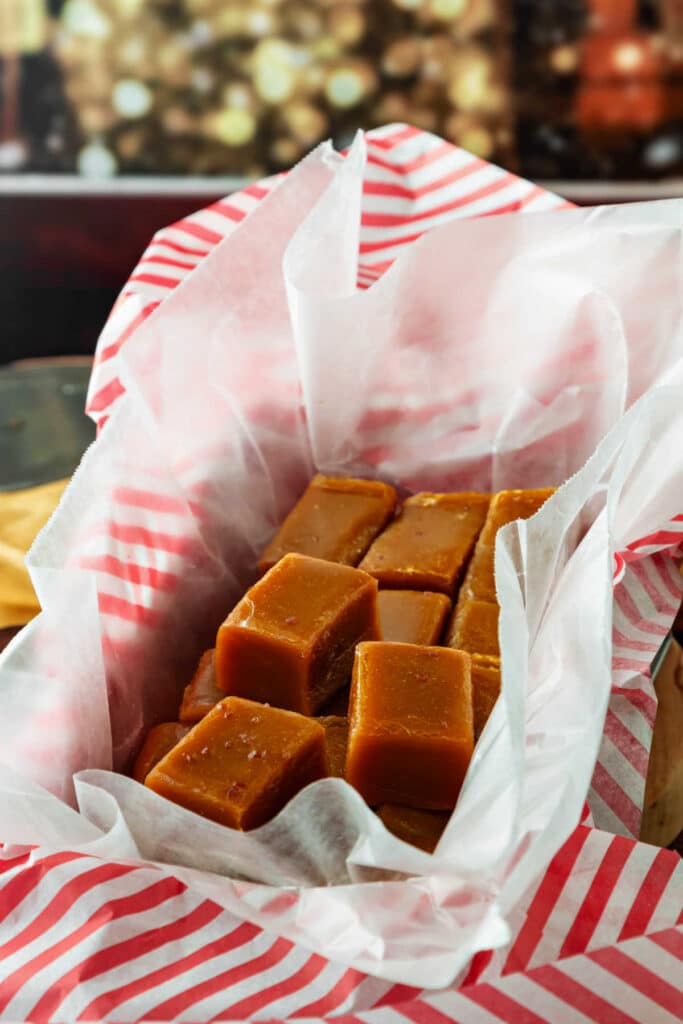
Chewy Butterscotch Candy, At a Glance
✔️Skill Level: Intermediate
✔️Skills: Cooking Sugar, Patience
✔️Type: Chewy Candy
✔️Number of Ingredients: 5
✔️Prep Time: 10 minutes
✔️Cook Time: about 15 minutes
✔️Yield: 48-64 pieces
Jump Straight to the Recipe
Pastry Chef Online Participates in Affiliate Programs. If you make a purchase through one of my links, I may earn a small commission. For more information click to read my disclosure policy
I am thrilled you are here to learn how to make this chewy version of a classic candy. Butterscotch is one of my favorite flavors, and I’m guessing you’re here because it’s one of your favorites, too!
The flavor of this candy is buttery, rich, and deep. Unlike my own recipes that I test and perfect, I am leaving this one with the same proportions in the newspaper article.
For that reason, some butter may leak out–it probably will–but most will get reabsorbed as the candy sits and crystallizes. Don’t be surprised if a bit of butterfat leaks out when you slice it, but most will get reabsorbed as the candy sits in the fridge.
Texture aside, if you want to experience the flavor of a true, authentic butterscotch candy recipe unadulterated with artificial ingredients or even any cream that will mute the flavor, do give this recipe a try.
And if you do try it, I have a favor to ask:
When you do make this recipe, it will help me and other readers if you:
✅Rate the recipes using the stars in the recipe card⭐⭐⭐⭐⭐
✅Leave a review when prompted in the recipe card (If it’s a positive review, and I hope it is, I’ll use it in the post as social proof)✍️
✅Leave a comment on the post📝
Thank you so much!😘
Why Chewy and Not Crunchy Butterscotch?
Using the original proportions of ingredients from the Doncaster recipe, the amount of treacle or molasses is much higher than what modern palates appreciate. And the longer you cook the molasses, the more bitter it gets.
I found that cooking the mixture to the firm/hard ball stages yields a delicious, deep butterscotch flavor that is molasses-forward but not super bitter. Continuing to cook the ingredients to anywhere from 285F to 300F or so just brings out more bitterness than most Americans enjoy.
If you would prefer to make butterscotch hard candy, I have a recipe with a more modern flavor profile (less molasses) that I think you will really enjoy.
Or you can go ahead and cook this version to hard crack and then decide if you’re a fan or not.
The Difference Between Caramel and Butterscotch
In the butterscotch versus caramel post, I said that both confections require salt, although butterscotch needs more than caramel.
And then I thought of that 1848 “recipe” for traditional Doncaster butterscotch, calling for one pound each of sugar and butter and a quarter pound of treacle.
I was also pondering the fact that the proportion of sugar to butter in butterscotch is 1:1 while butter doesn’t necessarily play a role in caramel, and that’s when it hit me.
Both confections were probably originally made using salted butter. So, the more butter called for, the more salt the end product contained. —Pronouncement by Me based on nothing but conjecture. But it feels right, doesn’t it?
I mean, back before refrigeration, salt was put in the butter as a preservative, so it stands to reason that the butter Back Then was Pretty Darned Salty.
I read on OChef.com that some salted butter can contain up to 3% salt, or about 3/4 teaspoon per stick. Or up to 1 whole Tablespoon per pound. So, if the original Doncaster recipe was made with a base of one pound of (presumably) salted butter, it would also contain about 1 Tablespoon of salt. Hence: salt is a Big Player in the flavor profile. Magical!
Stages of Sugar
Since temperature is critical to the success of candy-making, I want to make sure you’ve grabbed your Stages of Sugar chart. The butterscotch candy recipe is right below along with a couple of updates to avoid confusion when making the candy.
Stages of Sugar Chart
Equipment You’ll Need
Before we get started, here are the two most important pieces of equipment for candy making: an accurate kitchen scale and a precise thermometer.
If you own these items, great! If you don’t, I encourage you to pick up both. You certainly don’t have to purchase the specific models I suggest. Just make sure they’re accurate and you are good to go.
Still, I do have my favorites, and here they are for you to consider:
Don't let its small price and small size fool you. The Escali Primo is an accurate and easy-to-use food scale that I have used for years. It's easy to store, easy to use, has a tare function, and easily switches between grams and ounces/pounds for accurate measurements.
Ingredients
Here is the very short list of ingredients you’ll need to make butterscotch candy.
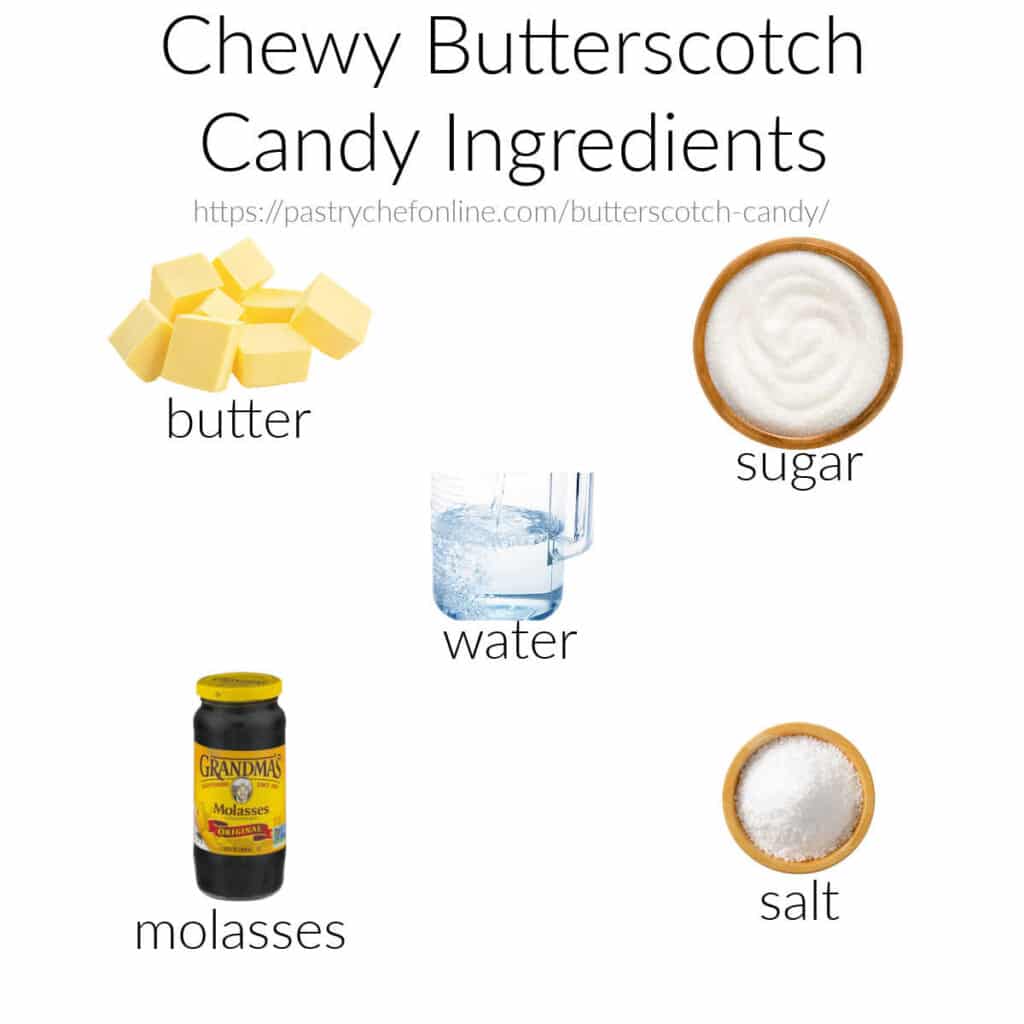
This is the part of the post where I usually tell you about substitutions you can make.
Since this recipe is not mine and shows the classic proportions of butterscotch ingredients, I’m letting the ingredients stand, as is.
The only addition I made was to add a bit of water to ensure the sugar dissolves completely. You could probably use coffee instead. I expect that would be good!
Procedure
Most candies are made in more or less the same way.
You put your ingredients in a pan, and cook them to a certain temperature.
You add mix-ins, and you stir or don’t.
Then you let it cool and cut it into pieces.
The tricky part is cooking each candy to the right temperature and then controlling crystallization through either stirring or just letting it alone.
For this butterscotch, you’ll:
- Cook the mixture to 250F.
- Pour it into a lined pan and leave it alone
- Sprinkle with a little finishing salt if desired
- Let it sit out for about 24 hours
- Cut and store in the fridge
Here are some image collages to talk you through it:
Mixing the Ingredients
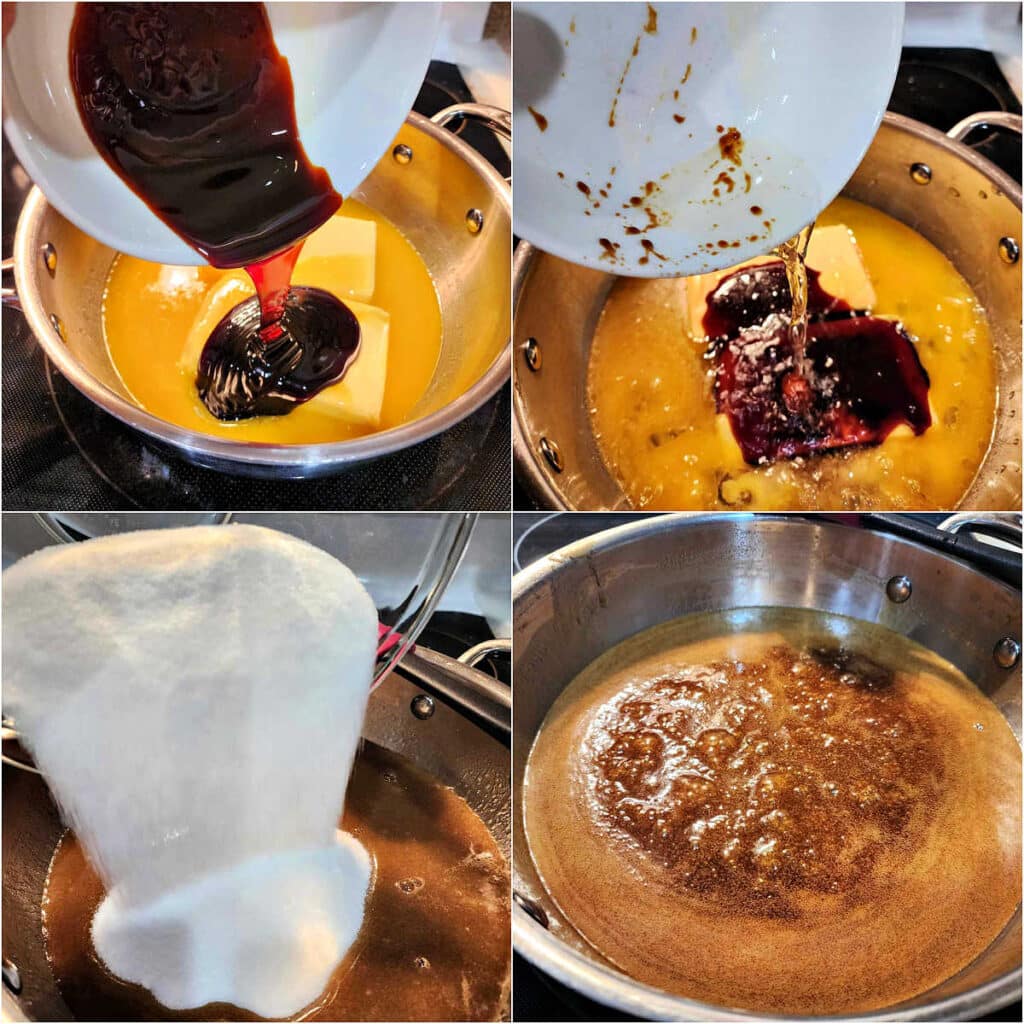
- Add the butter and salt to the pan. Once the butter is partially melted, add the molasses.
- Pour in some water. The water ensures the sugar will dissolve completely as the mixture is coming to a boil.
- Dump in the sugar after the butter has melted completely. Stir and stir to make sure the ingredients are smooth with no gritty texture of undissolved sugar crystals before heating it to a boil.
- Once the ingredients come to a boil, you’ll start to monitor the temperature.
Cooking the Candy
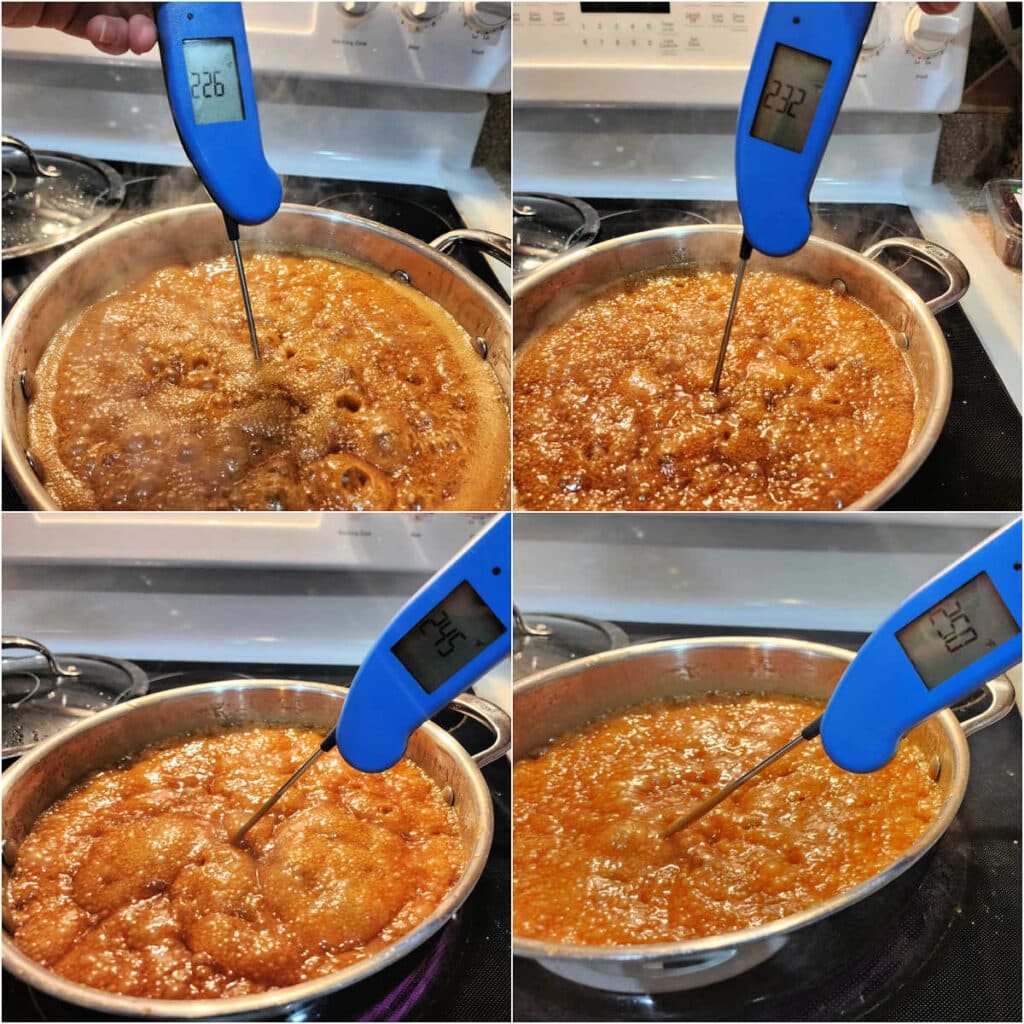
Keep the candy at a nice, rolling boil, and check the temperature periodically with an instant-read thermometer.
You are shooting for 250F.
The temperature might stick at 223-226F for a fairly long time. After it breaks 226F, the temperature will rise a bit more quickly.
Generally speaking, the higher the temperature climbs, the faster it heats, so keep an eye on it.
Panning and Cutting the Candy
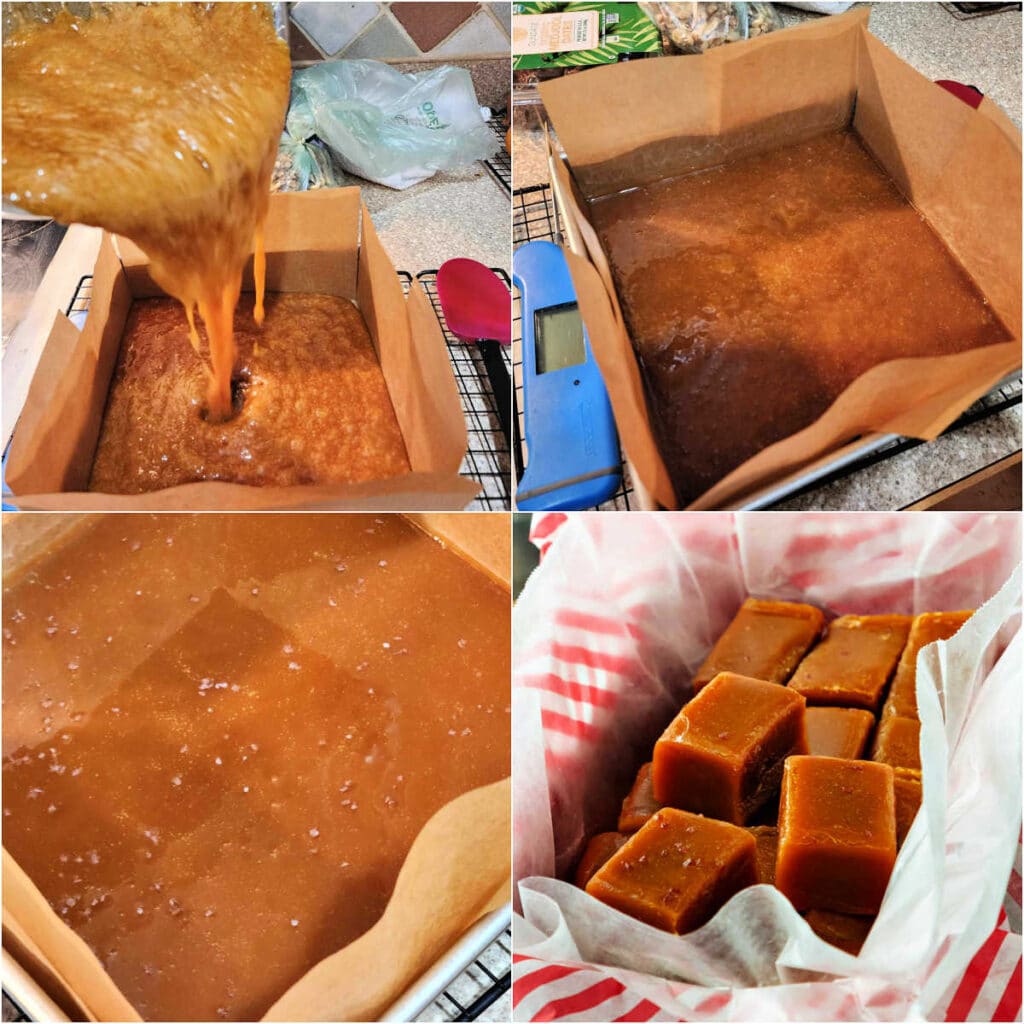
- Once your butterscotch hits your desired temperature (250F for a relatively soft-at-room temperature chewy candy that will not stick to your teeth when you chew it), immediately pour it into your prepared pan. Line your pan one way (or both ways to be safe) with either foil or parchment paper folded to fit exactly.
- Once the candy is still and not bubbling anymore…
- …sprinkle with a little finishing salt if you’d like. The candy needs to sit out for a good 24 hours with a tea towel over it (a lint-free kitchen towel) so it crystallizes correctly and so the butter has a chance to reabsorb into the candy.
- Score and slice the candy into your desired shapes.
Jenni says: To get nice cuts that don’t squish your candy, refrigerate the slab of butterscotch for 30-45 minutes before slicing. I like to use a pizza cutter for this. Store the cut candy in the fridge.
Adjusting Temperature for High Altitude Candy Making
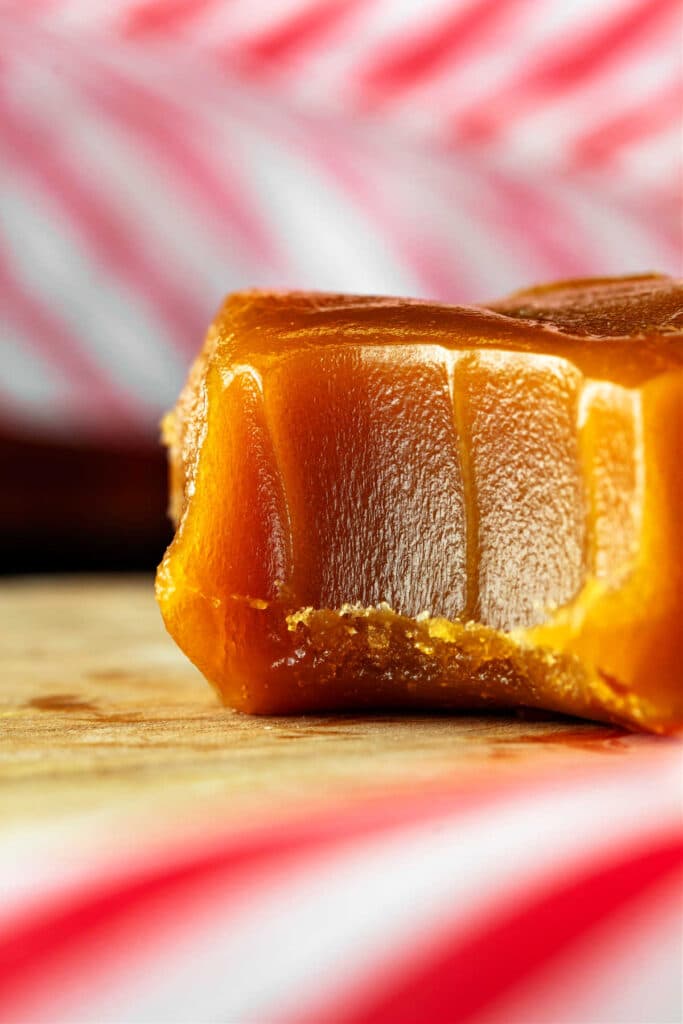
Reader Charlie recently commented saying that his candy tasted great but was crumbly. He did his own research and realized that it was because (for example) 234F was too hot at his altitude (5000 ft above sea level).
This information will help a lot of you, so thank you so much, Charlie. And I know your next batch of candy will be Perfection!
Here’s the rule: reduce the temperature by 1 degree for every degree below sea level boiling temperature of 212F.
Make Adjustments for your Elevation Like This:
- Take the temperature of your boiling water.
- Subtract 1 degree from the target temperature for every degree below 212F your water boils.
If your water boils at 208F, then you will have to stop cooking your sugar at 230F (4 degrees below 234F since your water boils at 4F below 212F).
Another example: If you’re at 5000 ft above sea level, water *should* boil at 207F (check with a thermometer). Since the soft butterscotch needs to be cooked to 250F at sea level, you’ll only need to cook it to 245F at 5000 ft.
For reference, I found this Altitude Conversion Chart in a booklet titled “The Art of Candy Making” from the USU Extension/Utah County in Provo, Utah.
Butterscotch Candy Q & A
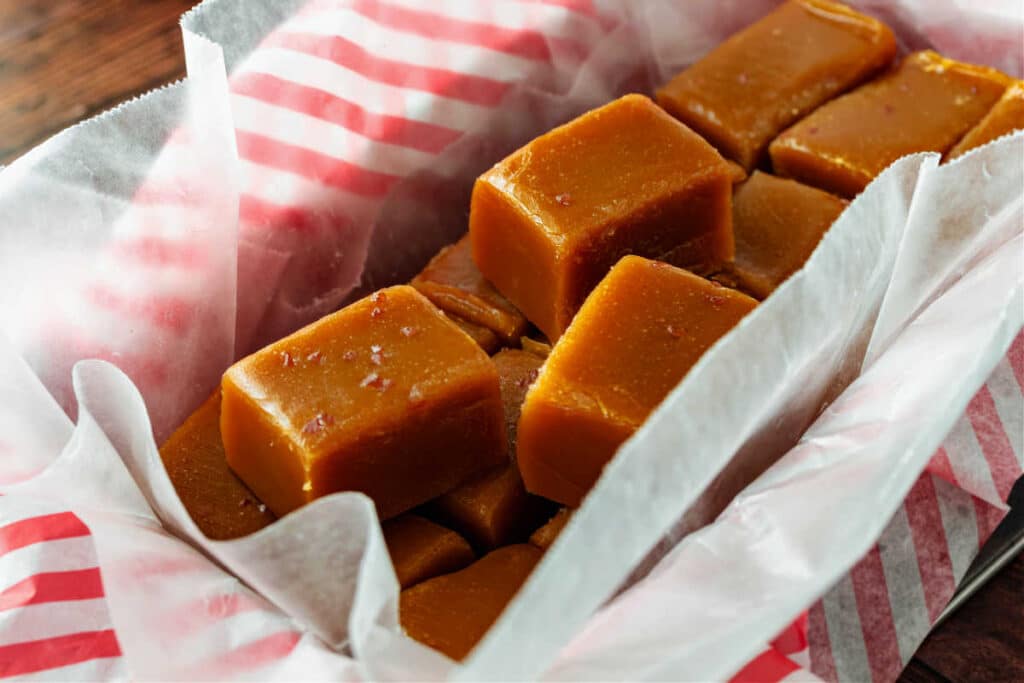
Cook the mixture to 260F rather than 250F. Keep in mind you’ll still need to let it crystallize for 24 hours. Since it will be firmer, score it while it’s still pretty soft so you have guidelines when you cut it completely once completely cool and crystallized.
Refrigerated, your candy should stay nice and fresh for a good 2-3 weeks.
Questions?
If you have any questions about this post or recipe, I am happy to help.
Simply leave a comment here and I will get back to you soon. I also invite you to ask question in my Facebook group, Fearless Kitchen Fun.
If your question is more pressing, please feel free to email me. I should be back in touch ASAP, as long as I’m not asleep.
It will help me and other readers so much if you take a moment to rate and leave a review for this recipe.
You can use the stars to rate 1-5 (5 is best), and leave a review in the comments. It helps me make adjustments if any are needed, and comments help others decide whether the recipe is worth making.
Other ways to share include pinning, and/or sharing on your favorite social media platform.
Thank you so much for taking the time!


Butterscotch Candy
Equipment
Ingredients
- 1 pound unsalted butter 4 sticks or 450 grams
- 10-14 grams fine sea salt or to taste (about 2-2 1/2 teaspoons)
- 4 oz water 1/2 cup or 113 grams
- 4 oz molasses, by weight and NOT by volume 112 grams, by weight. By volume: 1/4 cup plus 1 Tablespoon plus 2 teaspoons
- 1 pound granulated sugar 450 grams or about 2 1/4 cups
Instructions
- Cut a strip of non-stick foil or parchment to the same width as the bottom of an 8" or 9" baking dish. Line the pan, making sure the edges of the foil extend up and over opposite sides of the pan. Don't worry about the unlined sides.
- Spray the whole shebang very well with pan spray, especially the unlined sides. Set aside on a heat-proof surface. You can also choose to line the pan "both ways," covering all 4 sides like you can see in the photos. In that case, you won't need to use any pan spray.
- In a medium saucepan, melt the butter, along with the salt, over medium-low heat.
- Once the butter is about half melted, add the molasses and water, and continue heating, stirring occasionally, until the butter has completely melted but the mixture hasn't come to a boil yet.
- When the mixture is good and liquidy, add the sugar, increase the heat to medium to medium-high, and bring to a boil, stirring constantly until all the sugar has dissolved (it doesn't feel at all grainy when you rub a little between your fingers).
- Once the mixture comes to a good, rolling boil, cook the candy to 250F and then pour into your prepared pan. NOTE: You're not really supposed to stir during this part, but sometimes it's hard to stop yourself. If you do decide to stir, stir carefully with a clean, silicone spatula, and rinse it off between stirs.
- Let sit out until cool, and then score the candy into 1" squares for later cutting. Run a thin spatula between the unlined sides of the pan and the butterscotch, and and let it sit out, loosely covered with a lint-free towel, for about 24 hours in a cool kitchen.
- Remove to a cutting board, and cut into whatever shapes you want. This will make about 48-64 pieces of butterscotch, depending on how you cut them. NOTE: Because of all the butter in the candy, it will soften quickly at room temperature, so cut it and then store it in the fridge. A bit of butter may leak out when slicing, but most will get reabsorbed into the candy. See NOTES below for other target temperatures to make candies of different textures.
Did You Make Any Changes?
Notes
Nutrition
And if you think you don’t like butterscotch, I hope this recipe will help to change your mind.
Thanks for spending some time with me today. Have a lovely day.

Hi, y’all! I hope you’ve enjoyed this post and hopefully also learned a thing or two.
If you like my style, I invite you to sign up for my occasional newsletter, The Inbox Pastry Chef.
Expect updates on new and tasty recipes as well as a bit of behind-the-scenes action. I hope to see you there!



Join in Today!

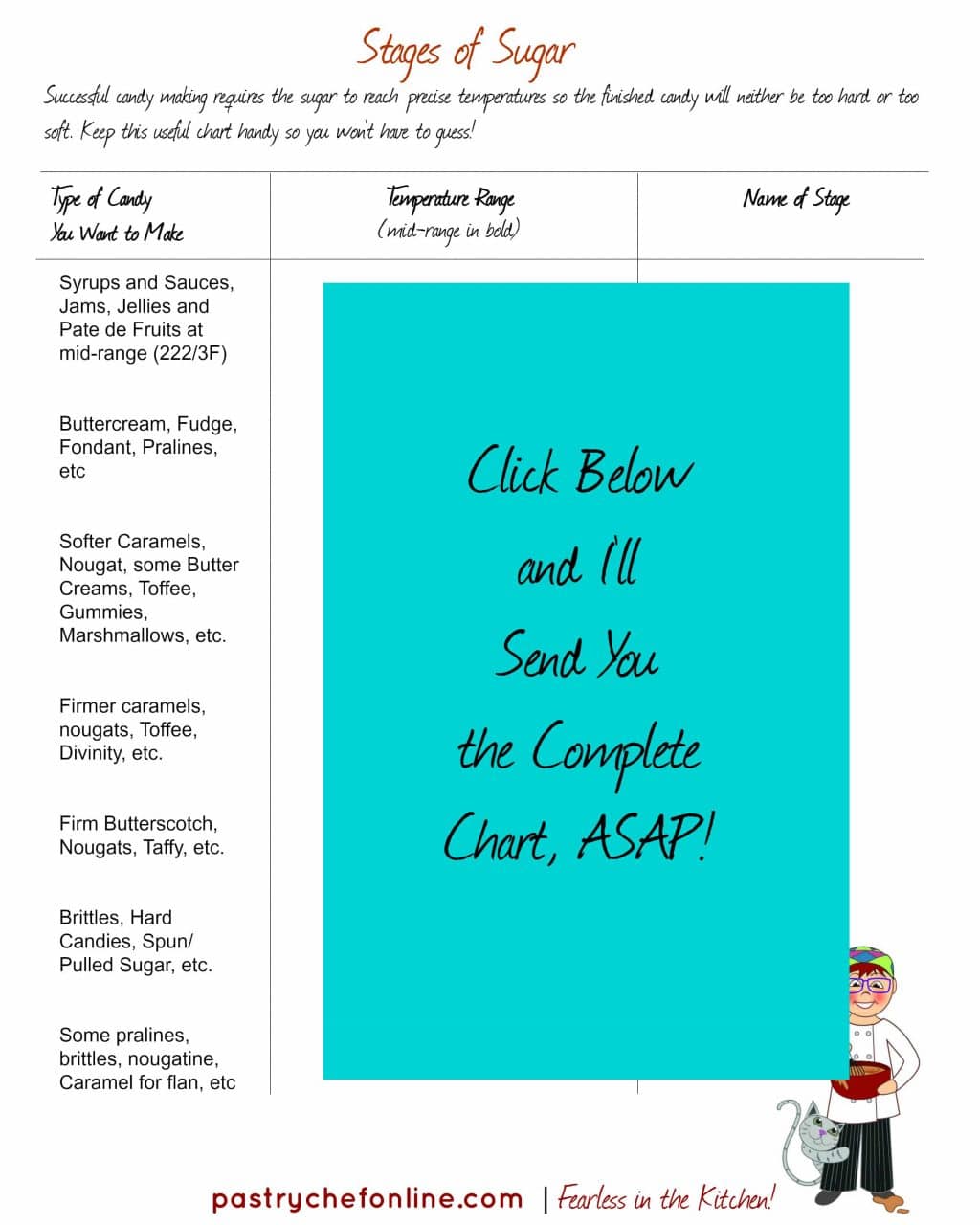
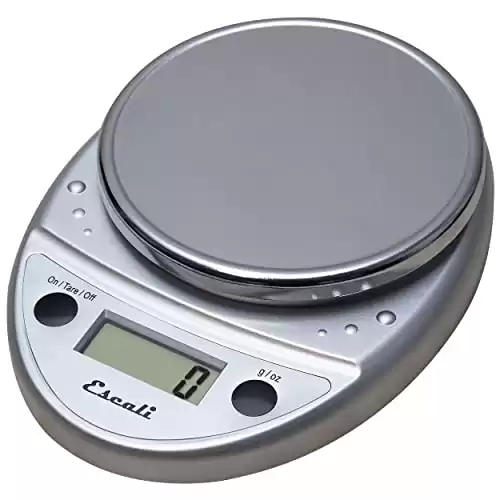
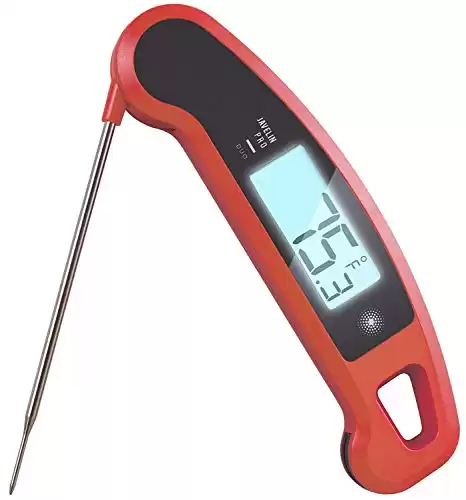



Instructions and tips were great and it was an easy recipe to make. The end result texture was awesome, both room temp and straight from the fridge! I like molasses, so it was a hit with me – hubby not so much a molasses fan, so ‘it’s ok’ was his verdict. I do like salted caramel, but this seemed a bit too much: I don’t remember if I used salted butter or not, but about 1 3/4 tsp salt, and I had to ask myself if the 2 – 2 1/2 tsp listed in the ingredient list was a typo. Next time I make it I’ll cut it back to about 1/2 tsp to see how I like it.
Thanks for the honest review! Yes, it’s a lot of salt. I definitely think it’s a better plan to weigh it, because 10-14 grams is 10-14 grams, while 2 teaspoons of table salt is wildly more salty than 2 teaspoons of kosher salt, for example. Glad you enjoyed the texture–I really love that candy. How it “chews” but doesn’t stick to teeth! 🙂
More of a question. Or two questions. 1) can this candy be cut into “chips”? I find all the commercial butterscotch chips to taste horrible and contain soy lecithin (allegedly an emulsifier, but is really the sludge left in soybean oil manufacturing and in reality lubricates for passing through forming machines and extends shelf life, but also causes migraine attacks in migraineures like myself and my family.) 2)Can this be made at an altitude of 5300 feet? I find when I make fudge, I can only get the syrup mixture to 225 degrees (instead of the recommended sea level temp of 236) before it crystallizes.
Hey Bruce. 🙂 Yes, you should be able to cut these small and use them as chips. They’ll be chewy, so as long as you’re good with that, go for it. I agree with you about commercially-produced chips. They’re gross and taste nothing like butterscotch. As to your altitude question, I just updated the post with a special section addressing making candy at altitude. You may have to clear your browser cache since you recently visited, but it will tell you how to make adjustments for your altitude. Enjoy the butterscotch!
Hello! I’ve been looking for a butterscotch candy recipe that might work as a substitute for butterscotch chips in a cookie. Do you think pieces of this candy would hold up alright in a cookie dough? (I totally understand I’ll get some melting in the oven, but wondering your take on it). Thanks!
Hey, Jack. I’ve not tried using this in cookies, but I have used honeycomb candy, and the parts that were inside the dough and not peeking out held up well. I think it’s definitely worth a shot, so if you do try it, please let me know how they turn out. You might also consider breaking up pieces of my hard butterscotch candy to use instead: https://pastrychefonline.com/butterscotch-hard-candy/
I have tried this recipe 3 times and each time the butterscotch burns. It usually starts from around 250/260F. Have you any idea where I’m going wrong? The only thing i don’t have is corn syrup but replaced with golden syrup.
Are you making the authentic *chewy* candy recipe? because this recipe doesn’t call for corn syrup or golden syrup (which is a fine substitute). The directions also say to cook to 250 and then you’re done, so I’m not sure why you’re cooking beyond that temperature. If making the hard candy, you are supposed to take it to 295-97F, and it can be a bit dicey because the temp goes up quickly once you get above 260F or so. The only other thing I can think to tell you is to maybe add some water at the beginning to make sure all your sugar dissolves before you take it to super-high temperatures. And if it’s the bitter molasses edge you are not a fan of, substitute white sugar and then add in some molasses (maybe a tablespoon or so) once you get to 260-265 or so. That way, the molasses won’t have as much of a chance to burn between 265 and the target temp. I hope that helps. I remember you commented a while ago on the other recipe. Have you tried the chewy version? Maybe try that one first, just because you don’t have to cook it as high? I do want you to have delicious better-than-Werther’s butterscotch, though, so I really hope these couple of modifications are useful.